|
Did you know Joshua Tree was once home to Columbian mammoths, saber-toothed cats, dire wolves, giant ground sloths, horses, camels, and llamas? How do we know this? Fossils! Fossils provide a window into the past and an opportunity to understand the mysteries of our planet beyond modern history. Fossils inform us about the past climate, extreme global events, volcanic activity, plate tectonics, ecological order, species diversity, and migration. Chemical analysis of fossils provides an account of past global temperature, ocean acidification, and asteroid impacts. The anatomy of the fossil provides insight to the organism's diet, position on the food chain, behavior, preferred environment, walking speed, bite force, and even intelligence. They show us how a species evolved over time and provide the missing links in the evolution of species and the path of evolution. They even give us an idea of how species adapt, migrate, or perish in a changing climate in the future. Unearthing the Past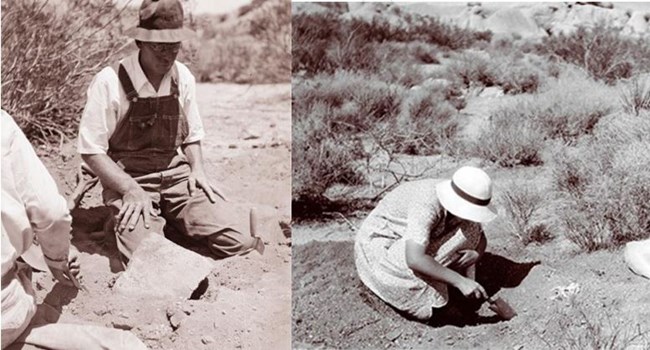
NPS Photo Paleontological studies in Joshua Tree go back nearly a century. William and Elizabeth Campbell conducted the first archaeological study in 1935, assisted by David Scharf and Chester Stock of Cal Tech. During their excavation, they found fossilized bones of horses and llamas, along with cultural artifacts. A Cooler, Wetter PlaceMost of Joshua Tree’s fossils date to the Pleistocene Epoch, from 11,700 years ago to 2.6 million years ago. This was a much wetter and cooler time. The area that is now Joshua Tree National Park was not a desert then. It had lakes and rivers and supported a broader group of animal species. At the end of the last ice age, the North American ice sheet gradually disappeared. This gave way to the Holocene Epoch from 11,700 years ago to the present. Joshua Tree developed a warmer and drier climate and eventually became a desert. The end of the Pleistocene Epoch is marked by the extinction or migration of many species. Species that scientists believe once roamed Joshua Tree: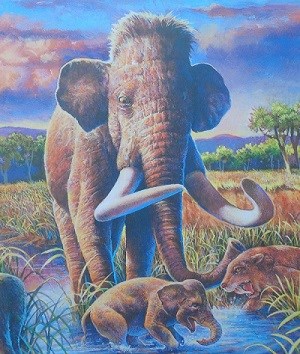
Columbian Mammoth (Mammuthus columbi)The Columbian Mammoth lived in Joshua Tree and had a range from Canada to Central America. They had large tusks but likely lacked the fur of the Wooly Mammoth. Like elephants, they had ridged teeth for chewing vegetation. They would have to spend a large part of the day eating to maintain their massive body weight. The Columbian mammoth stood up to 14 feet (4 meters) tall at the shoulder, was 13-15 feet long (4-5 meters), and weighed up to 22,000 pounds (10,000 kilograms)! Paleontologist have discovered mammoth tusks, molars, and rib fragments in the park. 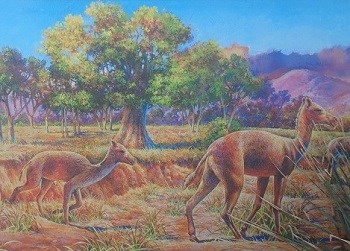
Camel (Camelops hesternus)Camels evolved in North America before migrating over the Bering Land Bridge into Asia. Camels originally adapted to the extreme cold. They have since evolved and now have a high tolerance for cold, heat, and dehydration. On our mural, they are depicted without humps. This is because we are not sure if the species in North America ever developed humps as soft tissues are not often preserved in the fossil record.
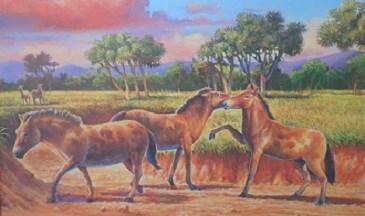
Horse (equus)Horses evolved in North America and spread to the rest of the world. Many species of horses existed in North America and at least two different species lived in Joshua Tree National Park. They went extinct at the end of the Pleistocene Epoch. These animals were all smaller than today's domestic horses. Their ancient ancestors, also related to camels and llamas, were browsers that grazed on grasses and shrubs. A browser can feed on many types of plants, making them a dietary generalist. This may be why the ancestors of horses, llamas, and camels were able to migrate out of the continent to survive today. 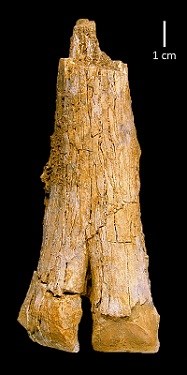
NPS / Eric Scott Llama (Hemiauchenia)Several species of llamas lived in North America during the Pleistocene Epoch. They were members of the Camelidae family, which include camels and llamas. While camel species migrated to Asia, llamas evolved and migrated to South America and developed into modern llamas, alpacas, and vicunas.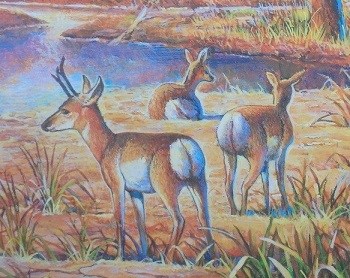
American Pronghorn (Antilocapra americana)American pronghorn have a range from Canada to Mexico. Their range previously included Joshua Tree before the species was nearly hunted to extinction in the early 1900s. The population has not returned to the park. The American pronghorn uses speed to avoid predators. It is the fastest mammal in North America and the second fastest in the world after the cheetah. 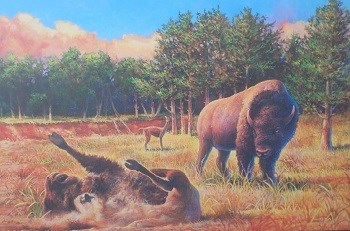
Bison (Bison antiquus and Bison occidentalis)Paleontologists found Bison fossils in the park in 2008. They are believed to come from the late Pleistocene Epoch. The first, now-extinct species found is named Bison antiquus. It was 15-25 percent larger than the modern bison. It reached up to 7.5 feet tall, 15 ft long, and weighed up to 3500 lbs. From tip to tip, the horns measured about 3 feet. The other species, Bison occidentalis, was proposed to have been a localized offshoot of Bison antiquus and part of evolution to the modern bison.
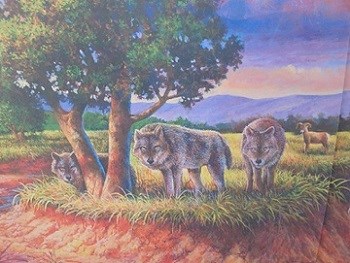
Dire Wolf (Canis dirus)Dire wolves grew slightly larger than modern-day gray wolves. Both species existed in North America during the Pleistocene period. A partial tooth was found in Joshua Tree, but it was not complete enough to determine if it belonged to a dire wolf or gray wolf. At the nearby La Brea Tar Pits in Los Angles, the fossils of thousands of dire wolves have been collected. 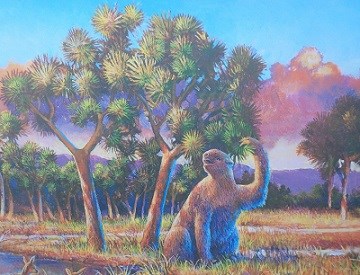
NPS Photo Giant Ground Sloth (Paramylodon harlani)The giant ground sloth was an important animal for the Joshua tree. They would eat the plant's large seeds and spread them through their dung, allowing the plant to migrate quickly. Without the giant ground sloth now, the Joshua tree is not able to establish itself as easily in new locations. This is a particular challenge because climate change is reducing their habitat. We haven’t found giant ground sloth fossils within the park. But due to the proximity of sloth fossils in caves, we are confident that Joshua Tree National Park was in the sloth’s range.
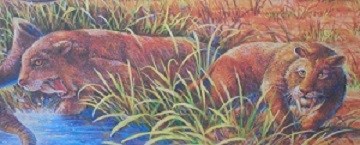
Sabor-toothed Cat (Smilodon fatalis)The saber-toothed cat was believed to have lived in the park. Its remains have not yet been found here, but its fossils have been found just outside of our borders near Eagle Mountain, CA. RodentsOur oldest fossil found in the park is a pocket gopher tooth. It was found in sediment that's older than 7.8 million years old! With detailed exploration and sampling in the park, we might find microfossils that are even older. Dinosaurs?!There haven’t been any dinosaur fossils found in Joshua Tree, but we believe dinosaurs lived here at one point. There are some very old rocks in the park from the time of the dinosaurs. However, these leftover rocks are igneous and metamorphic rocks that have no chance of preserving bones. Our oldest sedimentary rock in the southeast corner of the park is dated to the dinosaur era but has only produced pieces of wood. No dinos yet! 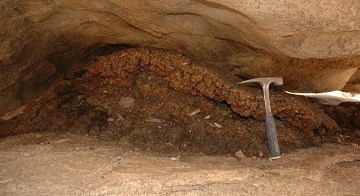
Julio Betancourt Plants and InsectsScientists have discovered fossilized plants and insects in the park by studying ancient pack rat middens that date back thousands of years. A midden is a collection of plant material and debris constructed into an insulating, protective shelter. Pack rats, also known as woodrats, will reuse middens and pass them on from generation to generation. The middens are preserved because the pack rat’s urine will dry, crystallize, harden, and actually preserve it’s contents. Middens examined were dated back from 1,000 to 47,000 years old using radiocarbon dating on fecal pellets and plant material. Dozens of plant species were found with the oldest dating back 30,000 years. This gives us an important history of the landscape and vegetation here. Scientists recently used a new DNA-analyzing technique to date darkling beetles found in the middens and discovered the parts were from 1,600, 2,000, 8,000, and 34,000 years ago. Pack rats also collect bones, feces, feathers, rocks, and even human artifacts—making them important to archeologists. Fossils and the FutureFossils not only inform us about our past, they can also give clues about our future. As we face a rapidly warming planet, many species will be forced to adapt, migrate, or perish. Looking back 11,700 years at the transition from the wetter, cooler Pleistocene Epoch to the warmer, dryer Holocene Epoch, allows us to see which species survived and why. We are now entering what many scientists call the Anthropocene Epoch, a time where humans drive changes in the earth’s climate and environment. Protecting and studying fossil resources allows us to uncover more information about the past. Please help us in the following ways:
|
Last updated: April 7, 2024
